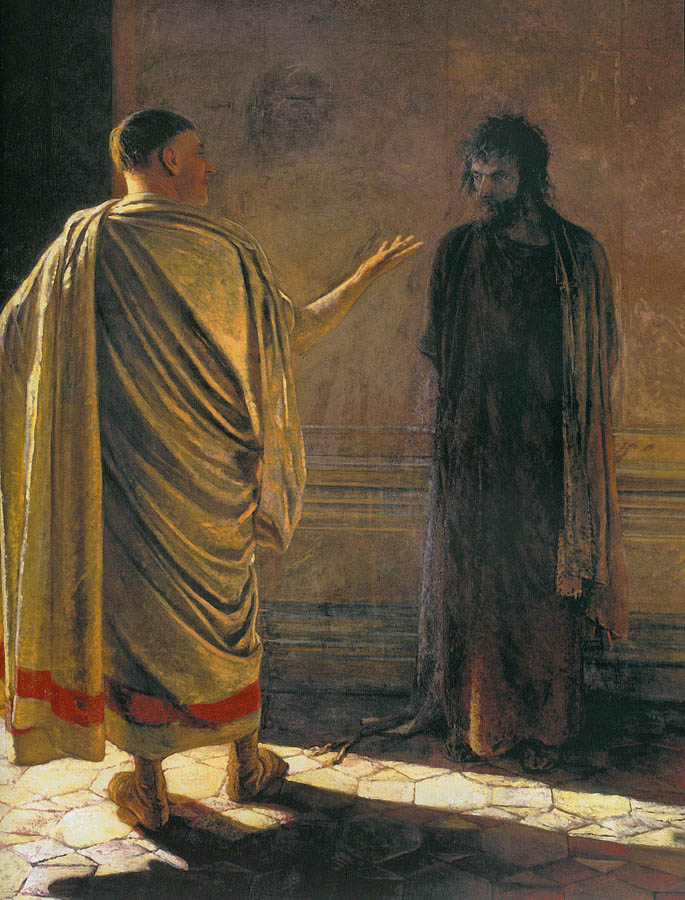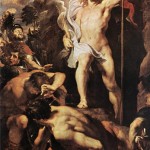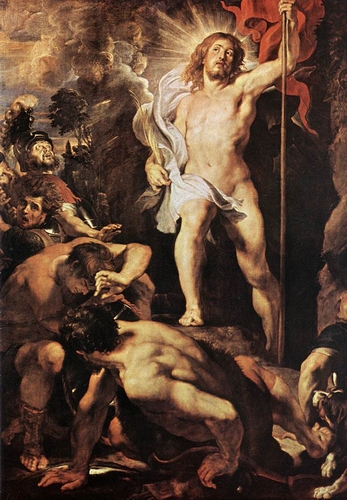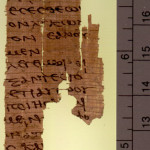
Click here to read Part I
Click here to read Part II
Click here to read Part III
A SURVEY & CRITIQUE OF THE DIFFERENT RESURRECTION HYPOTHESES PART IV: THE LITERAL VIEW INTERPRETATION
The Literal View
This is the explanation that the disciples gave–that God literally raised Jesus from the dead. There are two avenues to a knowledge of the resurrection of Jesus.
1)The Easter hymn writer says, “You ask me how I know He lives? He lives within my heart.”( Alfred H. Ackley, “He lives”) That is a perfectly valid answer on a personal level. Through a living encounter with the risen Lord Himself, anyone can know that Jesus has risen from the dead and is alive today. Even the most uneducated person that does not have the library resources or the leisure time to conduct a historical investigation for the resurrection, can know and know with confidence that Jesus has risen because he has an existential encounter with the living Lord Jesus today. On a personal level, this is a perfectly valid and a primary way, quite honestly, that people come to know that Jesus has risen.
2)On the other hand, because the resurrection is purported to be an event in history, that occurred in ordinary space and time, during the 1st century in what is modern-day Israel, it is open today to historical investigation. Therefore, we can also ask, how credible is this hypothesis as a historical explanation of what happened? Here one might be surprised to learn that the majority of New Testament historians today, who have investigated the subject of what happened to Jesus of Nazareth after His crucifixion, are agreed on the basic facts which undergird an inference to the resurrection of Jesus.
Dr. William Craig discovered this while undergoing his graduate studies at the University of Munich working on the historicity of Jesus’ resurrection. It was only slowly that this incredible realization began to dawn on Dr. Craig. It wasn’t just Evangelical Scholars, Mormon Scholars, or conservative scholars who believed in things like the post-mortem appearances of Jesus or the fact of His empty tomb. This actually represents the wide majority of main-stream New Testament criticism today. The historical grounds upon which the inference to Jesus’ resurrection is based are very widely acknowledged. It seems that these facts can be summarized under three main headings. In constructing a historical case for Jesus’ resurrection, there will be two major steps or parts to constructing such a case.
The first is to assemble the data that are to be explained. What are the empirical/historical facts that cry out for explanation? Fortunately there is wide agreement on what those facts are. Of course it is not unanimous, but the wide majority do agree on the facts. The second step will be to look at what is the best explanation of these facts. This is a two step case. We need to now re-review the six facts that the majority of New Testament scholars are agreed to.
Fact #1
Pilate, the Procurator, sentenced Jesus of Nazareth to death by crucifixion (Mark 15:12-15 “and delivered Jesus, when he had scourged hem, to be crucified”,  Luke 23:23-24. Luke uses the phrase “gave sentence”).
Luke 23:23-24. Luke uses the phrase “gave sentence”).
Fact #2
Jesus dies (Luke 23:46 “gave up the ghost”). In the year 70 ad, when Titus destroyed Jerusalem, so many of the rebels were crucified that he ran out of lumber.
Fact #3
After His crucifixion, Jesus was buried in a tomb by a member of the Jewish Sanhedrin named Joseph of Arimathea.
Not only do we know how Jesus was buried, but we also have the name of the person responsible for His internment. This is enormously significant to radical biblical critiques such as John Domic Crossan of the Jesus Seminar, who you will often see interviewed around Easter Time. Contrary to these radical critiques, this means that the burial sight of Jesus was known in Jerusalem to both Jew and Christian alike. If Jesus was buried by a member of the Jewish Sanhedrin, the court that condemned Jesus, then the location was known, not only to Christians, but to Jews as well. This is enormously important because a movement founded on belief in the resurrection of Jesus could never have flourished in Jerusalem if His corpse was buried in an unknown tomb. The burial of Jesus and its historicity is extremely important to establishing the resurrection. Scholars of the New Testament are convinced of the entombment of the body of Jesus by Joseph of Arimathea on the basis of evidence such as the following four points:
1) Jesus’ burial is attested in the very old tradition that is handed on by Paul in 1 Corinthians15:3-5: “For I delivered unto you first of all that which I also received, how that Christ died for our sins according to the scriptures; And that he was buried, and that he arose again the third day according to the scriptures: And that he was seen of Cephas (Aramaic name for Peter), then of the twelve:“
Paul not only uses here the typical Rabbinical terms – received and delivered – which were used in the handing on of oral tradition with regard to this information. But, vs 3-5, used in this formula, are a highly stylized form of writing which is filled with non-Pauline characteristics. Paul is not writing freely in his own hand here. He is quoting some kind of previous tradition that he says he himself “received” and then passed on to converts in Corinth. This has convinced all scholars today that Paul is doing just as he said, quoting from an older tradition that he had received after becoming a Christian on the Damascus road. This tradition probably goes back at least, if not before, to Paul’s fact finding visit to Jerusalem in 36 ad. In 36 ad, Paul goes back to Jerusalem, according to Galatians 1:18, 19 and spends two weeks with Peter and James; the very two people mentioned in the formula. When one remembers that Jesus was crucified in perhaps 30 ad, and Paul went back on the fact-finding trip in 36 ad, that means the tradition goes back to the first five years after Jesus’ crucifixion and possibly very early after the crucifixion. Even though Paul’s letter was written to the Corinthian Church in 55 ad and his visit to Corinth, when he gave this formula, would have been some years before that, the tradition itself reaches back to the first five years after the crucifixion. This is extremely important because we are not talking here of some writing that accrued decades and decades after the event. We are talking about something that goes back to just the first few years after the crucifixion. Given such a short time span, as well as Paul’s personal contact with the people named, it is idle to talk about legend in a case like this. You are dealing with history that has been mediated to Paul and by Paul.
2)The burial story is also part of very old source material used by Mark in writing his gospel. When you read the gospels, you will find that the gospels consist of brief snap-shots or anecdotes of Jesus’ life. These are loosely chained together and not always chronologically arranged. They have been compared to pearls on a neckless which might be differently strung together. However, when you get to the so-called Passion Story or Passion week, which is the last week of Jesus’ life in Jerusalem, then you do have one smooth, continuously running narrative. This suggests that the Passion Story was a unit, which was a whole, that Mark used as one of the sources of information when writing his Gospel. Most scholars already think that Mark was the earliest of the four Gospels (this is called Markan Priority); written sometime before the Jewish war in in 66 ad, which resulted in the destruction of Jerusalem. For instance, the Passion Story was one of Mark’s sources. That means the Passion Story is of course even older and goes back early in the Jerusalem Church. When you look at the four narratives, what you discover is that the accounts of Jesus’ Passion do not diverge from one another until after the burial account. They have different appearances narrated. Right up to the burial and the empty tomb account, they are unanimous in what they relate. This suggests that the burial account was indeed part of the pre-Markan Passion Story. Thus we have independent attestation of the burial from two of the oldest sources in the New Testament – the pre-Pauline tradition, quoted in 1 Corinthians 15 and the pre-Markan Passion Story used by Mark in writing his gospel. This is one of the most important criteria of historicity that historians use. When you have early, independent attestation of the same event, then you are likely on historical bedrock.
3) As a member of the Sanhedrin, the Jewish court that condemned Jesus to death, Joseph of Arimathaea is unlikely to be a Christian invention. There was a very strong resentment in the early Christian church toward the Jewish leadership for their instigating the crucifixion of Jesus. In Christian eyes, they were guilty of a judicial murder of Jesus. Look at 1 Thessalonians 2:15 to see how Paul inveighs against the Jewish leadership for the crucifixion of Jesus. In Acts 4:10 we see the Jews being blamed solely for the death of Jesus; no mention of the Romans at all. So we see that it would be highly unlikely that Christians would invent a member of the court that condemned Jesus, all of whom, Mark says, voted for Jesus’ death, who instead honors Jesus by giving him an honorable burial in his own tomb instead of allowing him to be dispatched by the Romans like a common criminal in a graveyard reserved for criminals. For that reason the burial of Jesus by Joseph of Arimethaea, a member of the Jewish Sanhedrin, is believed by most New Testament Scholars to be highly probable.
Now the question must be asked, why did Joseph of Arimathaea offer his tomb? This is disputed among scholars. In the later Gospels, we have independent attestation that Joseph was secretly a sympathizer of Jesus (John 19:38). In Mark 15:43, Joseph of Arimathaea was said to be, “an honorable counsellor, which also waited for the kingdom of God..” This is the same kind of language that is used to describe the message used and proclaimed by Jesus (the Kingdom of God is at hand). It is not inconsistent with Mark that this man could have been a sympathizer of Jesus. In Luke’s Gospel he actually says that Joseph of Arimathaea did not consent to the vote to condemn Jesus. Others have said that Joseph was only a delegate of the Sanhedrin to make sure the body was dispatched properly. It was very important in Judaism that the body was buried on the same day as execution. If this is the case, why does it not say that Joseph took care of the other two that were also crucified with Jesus? It seems that the Sanhedrin was content to allow the Romans to take care of them and put them in a common grave. Joseph however, singled out Jesus and buried Him in a tomb that was not used for criminals. This was one of the most expensive types of tombs; it had a rolling disc-shaped door. Only the nobility or the very rich could afford a tomb like this. Although the reason for Joseph burying Jesus’ body is disputed, the fact that Joseph did bury Jesus’ body is virtually undisputed.
4) No competing burial story exists. We have no other indication of how Jesus was buried. If the burial by Joseph of Arimathea were fictitious, then you would expect to find some trace of what really happened to the body of Jesus or at least competing legends. When you look at ancient tales of mythology, you will often find competing tales of myths or legends of how the hero died or what happened to him. All of the sources (5 of them all together) are all consistent on Jesus’ honorable interment by Joseph of Arimathea. That unanimity is a strong indication that we are on historical bedrock. For these reasons and a majority of other reasons, the majority of New Testament critics do believe that Jesus of Nazareth was buried in a tomb by a man named Joseph of Arimathea, a member of the Jewish Sanhedrin.
According to the late John A.T. Robinson of Cambridge University, the burial of Jesus in the tomb is, “One of the earliest and best attested facts about Jesus.” (John A. T. Robinson, The Human Face of God (Philadelphia: Westminster, 1973), p. 131.)
FACT #4:
On the Sunday following the crucifixion, Jesus’ tomb was found empty by a group of his women followers.
The difficulty of the empty tomb story is that these accounts of the empty tomb in the various Gospels are not harmonious. They are inconsistent with each other. This has caused some people to worry about their historicity. For example, Dr. Bart Ehrman says, “The accounts we have of Jesus’ resurrection [speaking mostly of the empty tomb narrative] are hopelessly contradictory in their details. It is an interesting exercise to make a list of the similarities and differences. The accounts don’t agree about who went to visit Jesus’ tomb on the third day, what they saw once they got there, what they were told when they arrived at the tomb, and what they did as a result of being told to do something. All these things are different in the Gospels in ways that are difficult to reconcile” (debategod podcast). So you have the problem that the various empty tomb narratives have inconsistencies in the details. However, what needs to be understood is, as Ehrmann puts it, these are in the secondary details. These sorts of discrepancies are to be found among any collection of independent historical accounts of some event. The core of the narrative however, is identical across the accounts, even if they differ in the secondary details. This is quite common in ancient history. For example, the ancient historians, Livy and Polybius, give two irreconcilable accounts of Hannibal’s crossing the Alps to attack Rome during the Punic Wars. But, nobody doubts that Hannibal did mount such a campaign trying to use elephants to attack Rome during the war. Even though the secondary accounts that we have are irreconcilable, the basic fact remains historically attested and acknowledged–the fact that Hannibal did attempt to cross the Alps and bring an attack upon Rome. When you look at the accounts, what you find is that we have very good ground for affirming the historical reliability of their core.
Dr. Ehrman, himself admits this. The following is a quote from Ehrmann with the Teaching Company:
“There are a couple of things that we can safely say for certain about Jesus after His death. We can say with relative certainty, for example, that He was buried. The earliest accounts are fairly unanimous in saying that Jesus was in fact buried by this fellow, Joseph of Arimathaea. And so it is relatively reliable that is what happened. We also have solid traditions to indicate that women found this tomb empty three days later. This is attested in all our Gospel sources, early and late. And so it appears to be a historical datam. And so, I think we can say, that after Jesus’ death, with probably some certainty, that He was buried, possibly by this fellow, Joseph of Arimathaea, and that three days later He appeared not to have been in the tomb.”
This quote, once again, is from Dr. Bart Ehrman, one of the most skeptical New Testament critics about the historical Jesus.
Michael Grant is a historian who wrote a book called, Jesus: An Historians Review of the Gospels, and this is what he says:
“True, the discovery of the empty tomb is differently described by the various Gospels. But, if we apply the same sort of criteria that we would apply to any other ancient literary sources, then the evidence is firm and plausible enough to necessitate the conclusion that the tomb was indeed found empty.”
This is a very strong statement by a secular historian. That despite the discrepancies found in the secondary details, “the evidence is firm and plausible enough to necessitate the conclusion that the tomb was in fact found empty.”
Indeed the Gospels agree with the following set of facts:
- Jesus of Nazareth was crucified in Jerusalem during the Passover Feast.
- Having been arrested and convicted on charges of blasphemy by the Jewish Sanhedrin and then slandered before the procurator, Pilate, on charges of treason.
- He died within several hours and was buried Friday afternoon by Joseph of Arimathaea in a tomb which was shut with a stone.
- Certain women followers of Jesus, including Mary Magdalene, having observed his interment, visited Jesus’ tomb early on Sunday morning, only to find it empty.
- Thereafter Jesus appeared alive from the dead to the disciples, including Peter, who then became proclaimers of the message of His resurrection.
All four Gospels attest to these facts. You can add many more details if you include facts attested in three out of the four Gospels. Even though there are discrepancies between the empty tomb narrative, these are not significant enough to lead even skeptical New Testament scholars to think that the facts, as stated, are not historically attested. What are the reasons that scholars have come to these conclusions?
Among the reasons which have led most scholars to this conclusion are the following:
1. The empty tomb story is also part of the old passion source used by Mark. The passion source used by Mark did not end in death and defeat, but with the empty tomb story, which is grammatically of one piece with the burial story.
2. The old tradition cited by Paul in I Cor. 15.3-5 implies the fact of the empty tomb. For any first century Jew, to say of a dead man “that he was buried and that he was raised” is to imply that a vacant grave was left behind. Moreover, the expression “on the third day” probably derives from the women’s visit to the tomb on the third day, in Jewish reckoning, after the crucifixion. The four-line tradition cited by Paul summarizes both the gospel accounts and the early apostolic preaching (Acts 13: 28-31); significantly, the third line of the tradition corresponds to the empty tomb story. When you turn over to the Gospel of Mark, the earliest of the four Gospels, what corresponds to these four lines that Paul gives?
- Mark 15:33-41: You have the death of Jesus (the first line in the tradition cited by Paul).
- Mark 15:42-47: You have the burial in the tomb (second line of the tradition cited by Paul).
- Mark 16:1-6: You have the story of the empty tomb (third line).
- Mark 16:7 foreshadows the post-mortem appearances (fourth line).
Here we have a significant, very early, pre-Pauline formula, attestation of the empty tomb. Furthermore, the empty tomb correlates, as seen in Acts 13, with the early Apostolic message.
3. In Mark, the story is simple and lacks signs of legendary embellishment. All one has to do to appreciate this point is to compare Mark’s account with the wild legendary stories found in the second-century apocryphal gospels (forgeries from the 2nd century and later). According to The Gospel of Peter, it is a Roman Guard (without a doubt) guarding the tomb. Moreover the guard is not just there on Saturday, but he is set up on Friday. This insures that no one could have had anything going on Friday night, before the guard was set on Saturday, as Matthew records it. That apologetical gap has now been closed by the Gospel of Peter. The guard is set immediately and it is a Roman guard. Moreover, the tomb is surrounded by all of the Chief Priests and the Pharisees who are watching the tomb. There is also a huge crowd from the surrounding country side who have come to watch the tomb. So you have all the official witnesses there. Right? Not unqualified women. You have the Jewish leadership watching the tomb. Now what happens? In the night a voice rings out from heaven and the stone over the opening of the tomb rolls back by itself. Then two men descend from heaven and go into the tomb. Then a moment later, three men come out of the tomb. Jesus is seen coming out of the tomb with his head reaching up above the clouds and followed by a talking cross! This is how real legends look. They are filled with apologetical and theological motifs that are starkly missing from the Markan account. Mark is a bare-boned account that suggest this is not the product of legend.
4. The fact that women’s testimony was discounted in first century Palestine stands in favor of the women’s role in discovering the empty tomb. According to Josephus, the testimony of women was regarded as so worthless that it could not even be admitted into a Jewish court of law: “Do not admit the testimony of women because of the brashness and levity of their sex” ( Josephus, Antiquities of the Jews, 4.8.15). Later legendary story would certainly have made male disciples discover the empty tomb. The fact that the Gospels have women as the discoverers of the empty tomb is because, like it or not, they were the discoverers of the empty tomb! This would have been an awkward and embarrassing fact for the authors of the Gospels to record.
5. The earliest Jewish allegation that the disciples had stolen Jesus’ body (Matt. 28:15) shows that the body was in fact missing from the tomb. The earliest Jewish response to the disciples’ proclamation, “He is risen from the dead!” was not to point to his occupied tomb and to laugh them off as fanatics, but to claim that they had taken away Jesus’ body. Thus, we have evidence of the empty tomb from the very opponents of the early Christians.
One could go on, but I think that enough has been said to indicate why, in the words of Jacob Kremer, an Austrian specialist in the resurrection:
“By far most exegetes hold firmly to the reliability of the biblical statements concerning the empty tomb” (Jacob Kremer, Die Osterevangelien—Geschichten um Geschichte (Stuttgart: Katholisches Bibelwerk, 1977), pp. 49-50).
The appearance traditions in the Gospels provide multiple, independent attestation of these appearances. This is one of the most important marks of historicity. The appearance to Peter is independently attested by Luke, and the appearance to the Twelve by Luke and John. We also have independent witness to Galilean appearances in Mark, Matthew, and John, as well as to the women in Matthew and John.
FACT #5
On multiple occasions and under various circumstances, different individuals and groups of people experienced appearances of Jesus alive from the dead.
This is a fact which is almost universally acknowledged among New Testament scholars. This is a fact that even John Domic Crossan of the Jesus Seminar believes. The following are the reasons for this unanimity among New Testament scholars:
1. The list of eyewitnesses to Jesus’ resurrection appearances which is quoted by Paul in I Cor. 15:5-7 guarantees that such appearances occurred. As explained earlier, this material is very early. Because the list goes back to within five years of Jesus’ crucifixion, it cannot be written off as a later legend. Paul knew Peter (Cephas), James, and the twelve, so he was able to confirm the appearance stories with them. Apparently Paul knew many of the 500 people who saw Jesus because he was aware that some had died by the time he wrote the list in a.d. 55, but most were still alive. Based on the earliness of the list and that Paul knew the people in the list, gives very strong evidence of the post-mortem appearances of Jesus.
2. The appearance traditions in the gospels provide multiple, independent attestation of these appearances. This is one of the most important marks of historicity. If you can show that an event is attested to independently and with multiplicity, it is more likely that the event occurred. What is meant by independent attestation? It does not mean that Matthew and Luke were drawing upon Mark and then writing their Gospels; we are not just counting heads here. What is meant is that when the different Gospel authors are writing, they are drawing on different sources for what they relate. Here is one illustration: Matthew clearly has a different source for the empty tomb narrative than Mark. Why? Because Matthew has an elaborate story of the guard at the tomb which isn’t found in Mark. Matthew is clearly supplementing whatever material he drew from Mark with this other tradition that he has about a guard being posted at the tomb. Luke and John also have this additional element of not only a women’s visit to the tomb, but the visit of two disciples who are named as Peter and then the beloved disciple in the Gospel of John. This again is independent of Mark because Mark ends with the women fleeing from the tomb and has nothing about a visit from these male disciples. Clearly Luke isn’t getting this from Mark. Given again the independence of Mark and Luke sources, they are not working with a common source either. This again would show independent sources for the empty tomb behind Mark, Luke, and John. That is the kind of work that is being reported here. We are dealing with genuinely independent sources. We are not just saying these are mentioned in different Gospels. The appearance to Peter is independently attested in Luke 24:34, and the appearance to the Twelve in Luke 24:36 and John 20:19,20. Here we have three independent accounts of the appearances of Jesus. We also have independent witness to Galilean appearances in Mark 16:7,14, Matthew 28:16, and John 21:1-7, as well as to the women in Matthew 28:9 and John 20:15.
3. Certain appearances have earmarks of historicity. For example, we have good evidence from the Gospels that neither James nor any of Jesus’ younger brothers believed in him during his lifetime (John 7:5). There is no reason to think that the early church would generate fictitious stories concerning the unbelief of Jesus’ family had they been faithful followers all along; these would be considered embarrassing reports. But it is indisputable that James and his brothers did become active Christian believers following Jesus’ death(Acts 1:16, 1 Corinthians 9:5). James was considered an apostle and eventually rose to the position of leadership of the Jerusalem Church. By the time Paul visits the Jerusalem Church, James (the brother of Jesus) is considered an Apostle. James is called one of the three pillars of the Jerusalem Church(Galatians 2:9) and eventually rises to the position of the sole leadership of the church in Jerusalem and the head of the Jerusalem Council (Acts 12:17; Acts 15:13-23; Acts 21:18; Galatians 1:19; Galatians 2:12 ). According to the first century Jewish historian Josephus, James was martyred for his faith in Christ in the late AD 60’s (Josephus, Antiquities Book 20: chapter 9). Now most of us have brothers. What would it take to convince you that your brother is the Lord, such that you would be ready to die for that belief? We have to have sufficient cause and merely the death of Jesus would not explain the change seen in James. If James didn’t believe during Jesus’ life-time that Jesus was the Messiah, Jesus’ crucifixion would only confirm that disbelief. The Messiah was supposed to establish the throne of David in Jerusalem, not be humiliatingly executed as a criminal. While this may rend James’ heart to see his brother crucified, it would only confirm his belief that his brother was a diluted fanatic who thought He was something that He just wasn’t, and so He was killed. The death of Jesus isn’t going to sufficiently explain the amazing transformation in James. But, the fact reported by Paul in 1 Corinthians 15 does explain the transformation. Can there be any doubt that this remarkable transformation in Jesus’ younger brother took place because, in Paul’s words, “then he appeared to James”? Jesus had apparently singled out His younger brother, James, for a transformative resurrection appearance that propelled him into a life of Christian service and leadership.
Another post-mortem appearance that has special credibility would be that reported in John 21 when the disciples are fishing and Jesus appears to them. The reason being that the Apostles appear to have returned to their old way of life rather than being involved in the task of missionary work. This makes the appearance of Jesus seem especially credible.
So, even a critic like Gerd Lüdemann, who is the leading German New Testament skeptic concerning Jesus’ resurrection, admits:
“It may be taken as historically certain that Peter and the disciples had experiences after Jesus’ death in which Jesus appeared to them as the risen Christ” (Gerd Lüdemann, What Really Happened to Jesus?, trans. John Bowden (Louisville, Kent.: Westminster John Knox Press, 1995) pg. 80).
The only question really is how you will explain these appearances. Can you explain them psychologically, as hallucinatory experiences, or as religious visions?
At this point we are not looking at how to best explain these facts. This is a two-step argument. What is being done here is looking at the inductive data base; what happened to Jesus of Nazareth? No one can object to the historian asking these types of questions any more than a Civil War historian asking, what happened to the body of Abraham Lincoln? There was actually a plot to steal Lincoln’s body out of the grave in Springfield. Any American Historian, who is working on that era, is going to want to know was the plot successful? Was the body missing or was the plot foiled? Those are just questions any historian can ask and ought to ask.
So far, there is nothing about these events that are being claimed as super-natural. The fact that a tomb is discovered empty – nothing super-natural about that. The fact that people had these experiences – nothing necessarily super-natural about that . We will get to how these facts are to be best explained later on. In regards to the historicity of these events, there’s really no dispute among New Testament scholars today that following Jesus’ death, various individuals and groups of people experienced appearances of Jesus alive from the dead.
FACT #6
The original disciples believed that Jesus was risen from the dead despite their having every predisposition to the contrary.
Think of the situation the disciples faced after Jesus’ crucifixion:
1. Their leader was dead and Jews had no belief in a dying, much less rising, Messiah. The Messiah was supposed to throw off Israel’s enemies (Rome) and re-establish a Davidic reign—not suffer the ignominious death of a criminal. The idea that the Messiah would be humiliatingly executed by His enemies as a common criminal was just a contradiction in terms. The crucifixion of Jesus was not only disastrous for His followers because their leader had died, but also because it exposed any Messianic pretensions He might have had as being utterly vacuous and unfounded.
2. According to Jewish law, Jesus’ execution as a criminal showed him out to be a heretic, a man literally under the curse of God. Deut. 21:23 says, “His body shall not remain all night upon the tree, but thou shalt in any wise bury him that day; (for he that is hanged is accursed of God;) that thy land be not defiled, which the Lord thy God giveth thee for an inheritance.” First century Jews applied being hanged from a tree to crucifixion. The catastrophe of the crucifixion for the disciples was not simply that their Master was gone, but that the crucifixion showed, in effect, that the Pharisees had been right all along, that for three years they had been following a heretic, a man accursed by God!
shall not remain all night upon the tree, but thou shalt in any wise bury him that day; (for he that is hanged is accursed of God;) that thy land be not defiled, which the Lord thy God giveth thee for an inheritance.” First century Jews applied being hanged from a tree to crucifixion. The catastrophe of the crucifixion for the disciples was not simply that their Master was gone, but that the crucifixion showed, in effect, that the Pharisees had been right all along, that for three years they had been following a heretic, a man accursed by God!
3. Jewish beliefs about the afterlife precluded anyone’s rising from the dead to glory and immortality before the general resurrection at the end of the world. In Jewish thought, the resurrection was a general resurrection of all the righteous dead which would take place at the end of the world at judgement day. There is absolutely nothing in Jewish literature that would speak of a resurrection of someone as an isolated individual apart from the general resurrection. There is nothing in Jewish literature that speaks of the resurrection of an individual within history rather than the end of the world. In Judaism there is, what is called, re-vivification of the dead. An example would be Elisha raising people from the dead. In Jesus’ ministry, we have the story of Jairus’ daughter being brought back to life. We have the story of the widow of Nain’s son being brought back to life. Of course there is the story of Lazarus, Mary and Martha’s brother being brought back to life by Jesus. These were not, properly speaking, resurrections of the dead because this was not a resurrection to glory and immortality. These are just a re-vivification and a return to the mortal life. The person in a re-vivification is still mortal and will succumb to disease, old age, who is still sinful, etc. Therefore these stories don’t show an actual resurrection. The idea that someone would be resurrected from the dead, apart from the general resurrection of the dead, was just completely unknown in Judaism. Confronted with Jesus’ crucifixion, the best the disciples could do was to preserve their Master’s tomb as a shrine where his bones could reside until that day when all of Israel’s righteous dead would be resurrected by God to glory. For Jews, it was the bones that were important. It was the bones that were the principle object of the eventual resurrection of the dead. That is why they would carefully collect the bones of the dead after the flesh had decomposed and put them in ossuaries and then set them in tombs until the resurrection at the end of the world. The best the disciples could have done with Jesus’ remains was to preserve His tomb as a shrine where His bones could rest until that day when they and all of the righteous dead of Israel would be reunited with Him in the Kingdom of God. They wouldn’t come up with the outlandish and un-Jewish idea that He was already resurrected from the dead. However, despite every predisposition to the contrary, it is an incontrovertible fact that the original disciples did suddenly and sincerely come to believe that God had resurrected Jesus. That requires some sort of explanation. How do you explain the origin of the disciples’ belief in this very un-Jewish and outlandish idea.
Despite all this, the original disciples believed in and were willing to go to their deaths for the fact of Jesus’ resurrection. Luke Johnson, a New Testament scholar from Emory University, muses:
“…some sort of powerful, transformative experience is required to generate the sort of movement earliest Christianity was . . . .” (Luke Timothy Johnson, The Real Jesus (San Francisco: Harper San Francisco, 1996), p. 136.)
You have to have some sort of powerful, transformative experience in the lives of these people to generate the movement to explain what happened. N. T. Wright, an eminent British scholar, concludes:
“…that is why, as a historian, I cannot explain the rise of early Christianity unless Jesus rose again, leaving an empty tomb behind him” (N. T. Wright, “The New Unimproved Jesus,” Christianity Today (September 13, 1993), p. 26).
 4.When one looks at the Messianic prophecies in the Old Testament they give virtually no clue that that the Messiah wasn’t going to be this triumphant warrior king that was expected (see point number 1). His government was supposed to be without end. He was supposed to rule in Jerusalem. Scholars are generally agreed that you can’t explain the origin of the disciples belief in Jesus’ resurrection by saying they went back to the Old Testament and found these proof-texts that would lead them to believe He had been raised from the dead. Those proof texts just aren’t there. It is only in retrospect, after they have come to believe that He has risen from the dead, that they can go back to the Old Testament and find these proof texts like Psalms 16:10 (perhaps the only Old Testament scripture that can be interpreted as a bodily resurrection). Peter interprets Psalms 16:10 in light of Jesus’ resurrection (Acts2:27,31; 13:35-37); or Hosea 6:2, “After two days will he revive us: in the third day he will raise us up, and we shall live in his sight.” Other Old Testament proof texts would include: Pslams 22:1, Psalms 69:21, Isaiah 52:13, Isaiah 53 (the Suffering Messiah. These scriptures are read in light of the resurrection and new meaning is put into them. You would not, from those verses alone, come to the idea of the resurrection. Paul alludes to this in 2 Corinthians 3:14, and is spoken of in Luke 24:32 (he opened the scriptures to us). They could only be seen after you have come to believe that and then read them in retrospect. That is why the old view that the disciples came to believe in Jesus’ resurrection by reading the Old Testament is now virtually, universally rejected by New Testament scholars. The materials just are not there. They are too ambiguous. Acts 17:2 supports this view, “And Paul, as his manner was, went in unto them, and three sabbath days reasoned with them out of the scriptures..” When Paul would argue from the scriptures, he wouldn’t convince them all. Some would say he was a heretic, he was mad and then they would kick him out of the synagogue. Paul would then go onto another place (see Acts 17). The fact that not all Jews were convinced by Paul proof-texting the Old Testament proves the point.
4.When one looks at the Messianic prophecies in the Old Testament they give virtually no clue that that the Messiah wasn’t going to be this triumphant warrior king that was expected (see point number 1). His government was supposed to be without end. He was supposed to rule in Jerusalem. Scholars are generally agreed that you can’t explain the origin of the disciples belief in Jesus’ resurrection by saying they went back to the Old Testament and found these proof-texts that would lead them to believe He had been raised from the dead. Those proof texts just aren’t there. It is only in retrospect, after they have come to believe that He has risen from the dead, that they can go back to the Old Testament and find these proof texts like Psalms 16:10 (perhaps the only Old Testament scripture that can be interpreted as a bodily resurrection). Peter interprets Psalms 16:10 in light of Jesus’ resurrection (Acts2:27,31; 13:35-37); or Hosea 6:2, “After two days will he revive us: in the third day he will raise us up, and we shall live in his sight.” Other Old Testament proof texts would include: Pslams 22:1, Psalms 69:21, Isaiah 52:13, Isaiah 53 (the Suffering Messiah. These scriptures are read in light of the resurrection and new meaning is put into them. You would not, from those verses alone, come to the idea of the resurrection. Paul alludes to this in 2 Corinthians 3:14, and is spoken of in Luke 24:32 (he opened the scriptures to us). They could only be seen after you have come to believe that and then read them in retrospect. That is why the old view that the disciples came to believe in Jesus’ resurrection by reading the Old Testament is now virtually, universally rejected by New Testament scholars. The materials just are not there. They are too ambiguous. Acts 17:2 supports this view, “And Paul, as his manner was, went in unto them, and three sabbath days reasoned with them out of the scriptures..” When Paul would argue from the scriptures, he wouldn’t convince them all. Some would say he was a heretic, he was mad and then they would kick him out of the synagogue. Paul would then go onto another place (see Acts 17). The fact that not all Jews were convinced by Paul proof-texting the Old Testament proves the point.
It should be pointed out that the historian, Josephus, does report other Messianic figures around the time of Jesus who were also executed. N.T. Wright points out that no where in the 1st century b.c. to the 2nd century a.d., do we have any of the followers of these failed Messianic movements claiming that their, would-be king, was actually the Messiah after all or that he had been raised from the dead. Dr. Wright points out that when your favorite Messiah got himself killed, you basically had two choices: Either you went home or you got yourself a new Messiah. What happened in the case of Jesus is unique. It is extraordinary and cries out for some explanation.
What would cause this re-interpretation of scripture? What caused, what N.T. Wright calls, “mutations in Jewish belief” about the resurrection? These questions cry out for an explanation from historians.
In summary, there are six facts agreed upon by the majority of scholars who have written on these subjects which any adequate historical hypothesis must account for:
- Pilate, the Procurator, sentenced Jesus of Nazareth to death by crucifixion.
- Jesus died
- Jesus’ entombment by Joseph of Arimathea.
- The discovery of his empty tomb
- Jesus’ post-mortem appearances
- The origin of the disciples’ belief in his resurrection.
Now the question is: what is the best explanation of these six facts? Most scholars probably remain agnostic about this question. Historians look at the evidence, without prejudice, and form hypotheses based on the evidence. The hypothesis then needs to be weighed using specific criteria. This is how probability should be determined. The historian can get us to a historical conclusion (Jesus was raised from the dead) without coming to the conclusion that God raised Jesus from the dead. He/she can get us there without having to raise the second question, who raised Jesus from the dead? The historical conclusion has a theological implication (who was the best candidate to raise Jesus from the dead? Answer: God). We can divorce the historical conclusion from the theological implication.
Historians do this already in the case of Charlemagne who co-ruled with his brother in the 8th century ad. The two hated each other. Three years into their reign, Charlemagne’s brother died. Historians conclude that he died in 771. They don’t have to come to the conclusion of whether he died of natural causes or if Charlemagne had him killed. Likewise, historians can conclude that Jesus was raised from the dead without saying who raised him.
But the Christian can maintain that the hypothes that best explains these facts is, “God raised Jesus from the dead.”
Next week it will be argued that the best explanation of the six facts presented is that God resurrected Jesus from the dead. This will take us into Hume’s argument against miracles and Plantinga’s argument of dwindling probabilities and how we should access competing explanations of these six facts in order to find the best explanation.











Wow. This is amazing. Well done. I loved reading this and following your process. I’ve pondered off-and-on how this could be true: That he was indeed resurrected.
This is what I’ve come to: Every cell of my body is made of matter he touched in one way or an other. I find the idea that he was raised from the dead logically impossible. And yet I believe it right down to my bones. It’s like my DNA knows it. That’s all I have to say.
Melody,
Thanks for reading this post and commenting. It is not a very popular series to read – probably because it doesn’t push that hard against Mormon sensibilities and because it is heavy with history and philosophy. This series is truly a labor of love.
This part was super long. The upcoming post is not as long, but is heavy with philosophy. I come after Hume and Bart Ehrmann.
Matthew is the only Gospel that mentions guards at the tomb. John’s Gospel says nothing about guards. If John was an eyewitness, as Christians claim, isn’t that a pretty important detail to leave out of your story? The missing Roman guards in the Book of John raises an important issue. Christians often contend that it would have been impossible for anyone to have surreptitiously removed Jesus’ corpse from the tomb because there were guards posted at the tomb who would have prevented such an occurrence. Therefore, they argue, without any possibility for the body to have been quietly whisked away, the only other logical conclusion is that Jesus must have truly arisen from the dead. A stolen body hypothesis is impossible.
This argument completely collapses in John’s account, however, because according to the fourth Gospel, this is precisely what Mary thought had occurred! Mary clearly didn’t feel as though the scenario of Jesus’ body being removed was unlikely. In fact, according to John, that was her only logical conclusion. Clearly, Matthew’s guards didn’t dissuade John’s Mary from concluding that someone had taken Jesus’ body because Roman guards do not exist in John’s story.
To further compound the problem of the conflicting resurrection accounts, John’s Gospel continues to unfold with Mary returning to the tomb a second time, only to find two angels sitting inside the tomb. Mary is still unaware of any resurrection as she complains to the angels that someone had removed Jesus’ corpse. As far as John’s Mary is concerned, the only explanation for the missing body was that someone must have removed it, and she was determined to locate it.
But Mary stood weeping outside the tomb. As she wept, she bent over to look into the tomb; and she saw two angels in white, sitting where the body of Jesus had been lying12 , one at the head and the other at the feet. 13They said to her, “Woman, why are you weeping?” She said to them, “They have taken away my Lord, and I do not know where they have laid him.”
(John 20:11-13)
Although in Matthew’s account the angel emphatically tells Mary about the resurrection (Matthew 28:5-7), in John’s Gospel the angels do not mention that anyone rose from the dead. The angels only ask Mary, “Woman, why are you weeping?” Mary responds by inquiring whether the angels removed Jesus’ body. Then, Mary turns and sees Jesus standing before her, but mistakes him for the gardener. Mary is still completely unaware of any resurrection, and therefore asks the “gardener” if he was the one who carried away Jesus’ body. It is only then that Mary realizes that she was speaking to the resurrected Jesus.
When she had said this, she turned around and saw Jesus standing there, but she did not know that it was Jesus. 15 Jesus said to her, “Woman, why are you weeping? For whom are you looking?” Supposing him to be the gardener, she said to him, “Sir, if you have carried him away, tell me where you have laid him, and I will take him away.” 16 Jesus said to her, “Mary!” She turned and said to him in Hebrew, “Rabbouni!” which means Teacher.
(John 20:14-16)
It is at this final juncture of the narrative that the accounts of Matthew and John become hopelessly irreconcilable. The question every Christian must answer is the following: When Mary met Jesus for the first time after the resurrection, had the angel(s) already informed her that Jesus had arisen from the dead? According to Matthew, the angels did inform Mary of the resurrection, but in John’s account they did not. As we survey the divergent New Testament accounts of the resurrection, we see that we are not just looking at contradictory versions, we are reading two entirely different stories!